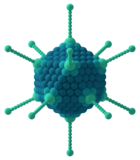Portal:Viruses/Selected virus/10
Adenoviruses are a group of non-enveloped DNA viruses that make up the Adenoviridae family. At 90–100 nm in diameter, they are the largest known viruses to lack an envelope. Unique spikes or fibres protrude from the icosahedral capsid, with knobs that bind to the receptor on the host cell. The linear double-stranded genome is 26 to 48 kb long, encodes 23 to 46 proteins, and has a 55 kDa protein attached to each end.
Adenoviruses infect a broad range of vertebrates, including humans, livestock, horses, dogs, bats and other mammals, as well as birds and reptiles, and usually cause infections of the upper respiratory tract. The virus is very stable. Transmission can occur by respiratory droplets or via faeces, with swimming pools being a common source of infection. A total of 57 serotypes, grouped into 7 species, have been found in humans; they cause a wide range of illnesses including mild respiratory infections, conjunctivitis and gastroenteritis. Some types have been associated with obesity. In people with an immunodeficiency they can cause life-threatening multi-organ disease. No antiviral treatment or vaccine is generally available; hand washing is the best way to prevent infection. Adenoviruses are an important viral vector for gene therapy. An oncolytic adenovirus has been approved in China for the treatment of head and neck cancer.

